Evidence-Based Medicine Critical Appraisal: IMPROVE-IT Study Analysis
VerifiedAdded on 2022/08/13
|12
|2978
|12
Report
AI Summary
This report critically appraises the IMPROVE-IT study, a randomized, double-blind trial investigating the effect of adding ezetimibe to statin therapy in patients with acute coronary syndrome. The study design, including its placebo-controlled nature and blinding techniques, is examined. The analysis methodology, funding sources, potential conflicts of interest, and the clinical appropriateness of the primary endpoint are evaluated. Statistical analysis, reporting of results, and clinical significance, including absolute risk increase and number needed to harm, are also discussed. The report addresses the applicability of the study's findings to a specific patient scenario (Mr. Burns), considering factors like age, smoking history, and current medication. It also assesses the study's findings in relation to renal function and appropriate dosages. Finally, the report evaluates the journal's quality and the overall clinical relevance of the study's results in the context of the patient case. The study concluded that combination therapy is more beneficial in reducing the risk of cardiovascular events compared to statin monotherapy.
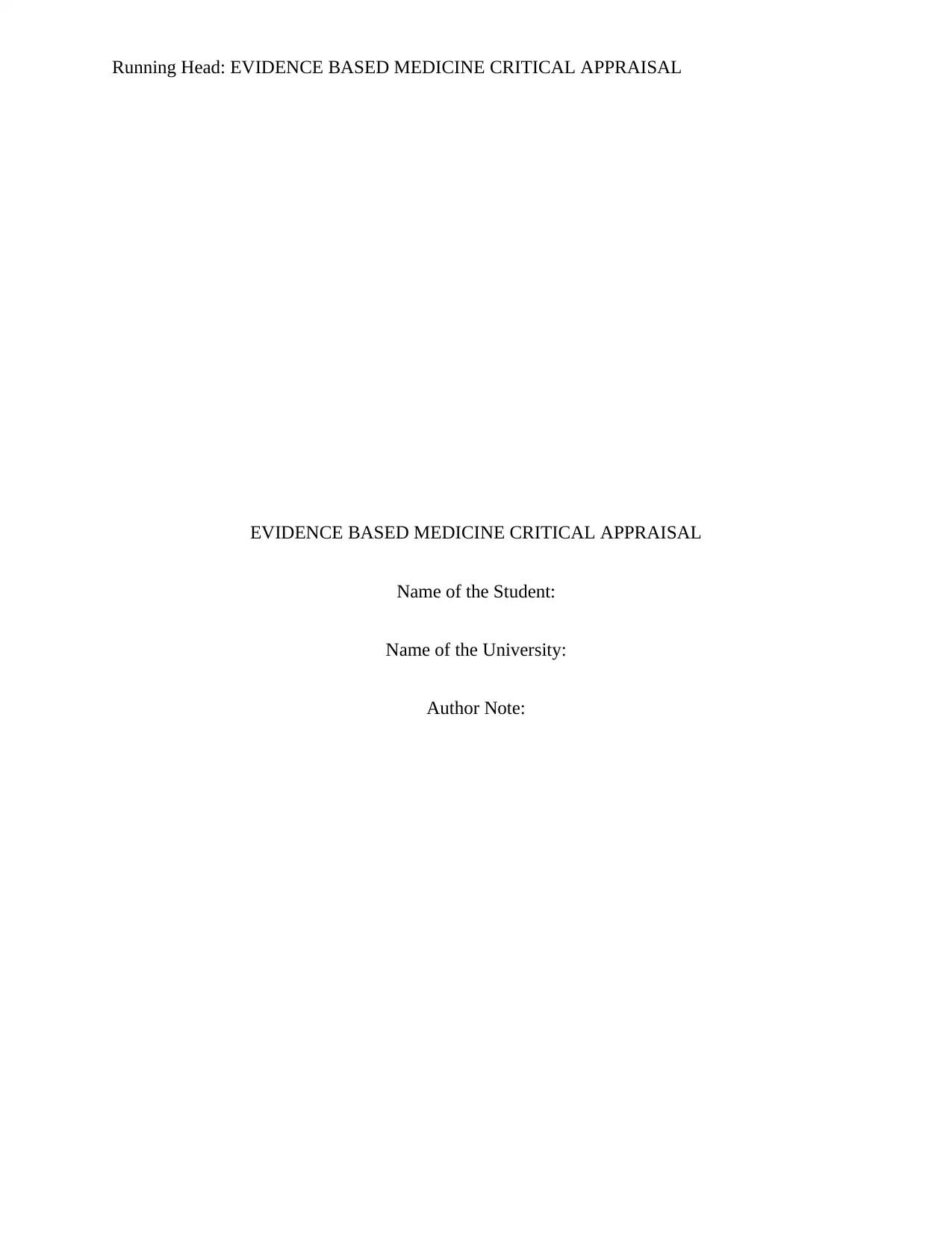
Running Head: EVIDENCE BASED MEDICINE CRITICAL APPRAISAL
EVIDENCE BASED MEDICINE CRITICAL APPRAISAL
Name of the Student:
Name of the University:
Author Note:
EVIDENCE BASED MEDICINE CRITICAL APPRAISAL
Name of the Student:
Name of the University:
Author Note:
Paraphrase This Document
Need a fresh take? Get an instant paraphrase of this document with our AI Paraphraser
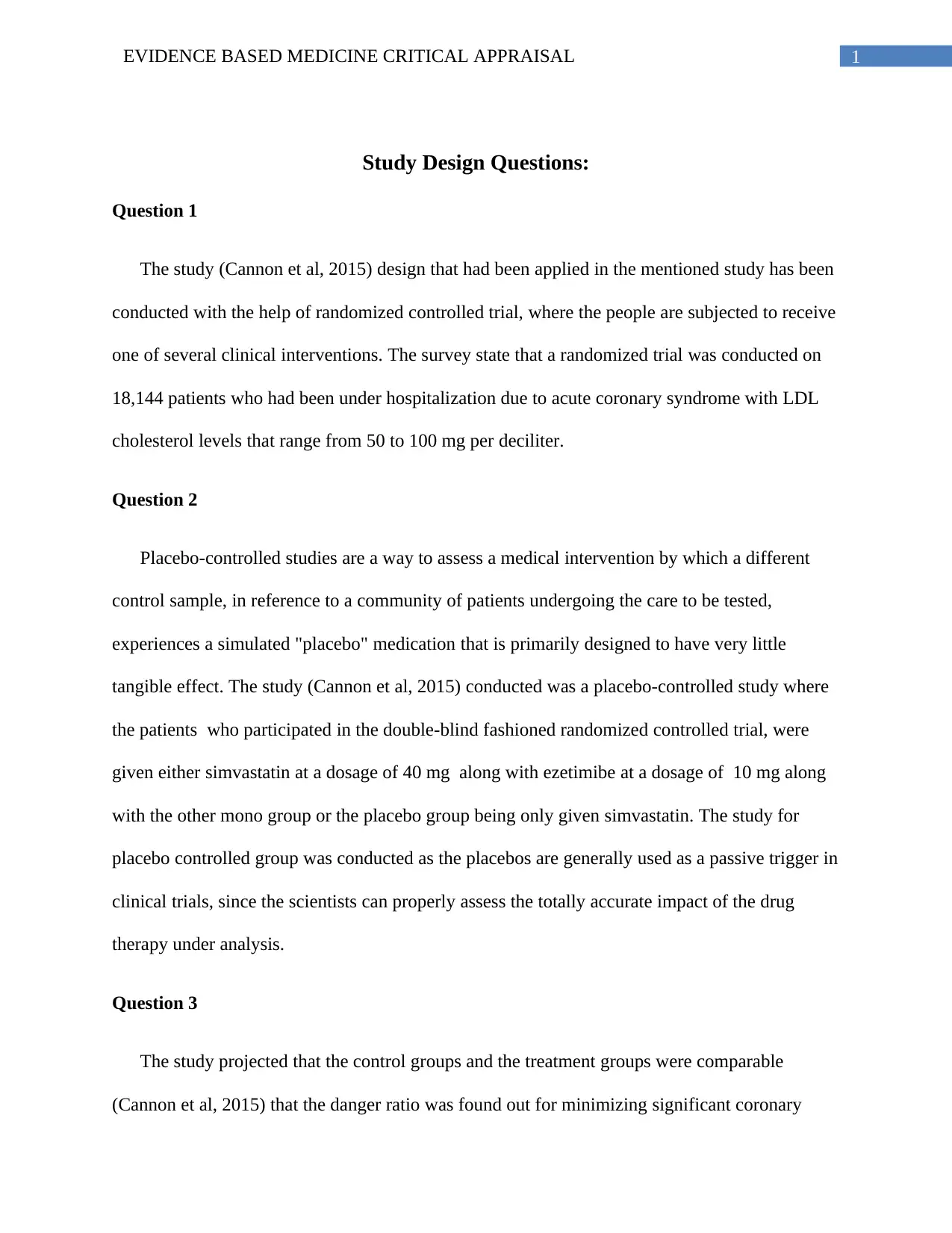
1EVIDENCE BASED MEDICINE CRITICAL APPRAISAL
Study Design Questions:
Question 1
The study (Cannon et al, 2015) design that had been applied in the mentioned study has been
conducted with the help of randomized controlled trial, where the people are subjected to receive
one of several clinical interventions. The survey state that a randomized trial was conducted on
18,144 patients who had been under hospitalization due to acute coronary syndrome with LDL
cholesterol levels that range from 50 to 100 mg per deciliter.
Question 2
Placebo-controlled studies are a way to assess a medical intervention by which a different
control sample, in reference to a community of patients undergoing the care to be tested,
experiences a simulated "placebo" medication that is primarily designed to have very little
tangible effect. The study (Cannon et al, 2015) conducted was a placebo-controlled study where
the patients who participated in the double-blind fashioned randomized controlled trial, were
given either simvastatin at a dosage of 40 mg along with ezetimibe at a dosage of 10 mg along
with the other mono group or the placebo group being only given simvastatin. The study for
placebo controlled group was conducted as the placebos are generally used as a passive trigger in
clinical trials, since the scientists can properly assess the totally accurate impact of the drug
therapy under analysis.
Question 3
The study projected that the control groups and the treatment groups were comparable
(Cannon et al, 2015) that the danger ratio was found out for minimizing significant coronary
Study Design Questions:
Question 1
The study (Cannon et al, 2015) design that had been applied in the mentioned study has been
conducted with the help of randomized controlled trial, where the people are subjected to receive
one of several clinical interventions. The survey state that a randomized trial was conducted on
18,144 patients who had been under hospitalization due to acute coronary syndrome with LDL
cholesterol levels that range from 50 to 100 mg per deciliter.
Question 2
Placebo-controlled studies are a way to assess a medical intervention by which a different
control sample, in reference to a community of patients undergoing the care to be tested,
experiences a simulated "placebo" medication that is primarily designed to have very little
tangible effect. The study (Cannon et al, 2015) conducted was a placebo-controlled study where
the patients who participated in the double-blind fashioned randomized controlled trial, were
given either simvastatin at a dosage of 40 mg along with ezetimibe at a dosage of 10 mg along
with the other mono group or the placebo group being only given simvastatin. The study for
placebo controlled group was conducted as the placebos are generally used as a passive trigger in
clinical trials, since the scientists can properly assess the totally accurate impact of the drug
therapy under analysis.
Question 3
The study projected that the control groups and the treatment groups were comparable
(Cannon et al, 2015) that the danger ratio was found out for minimizing significant coronary
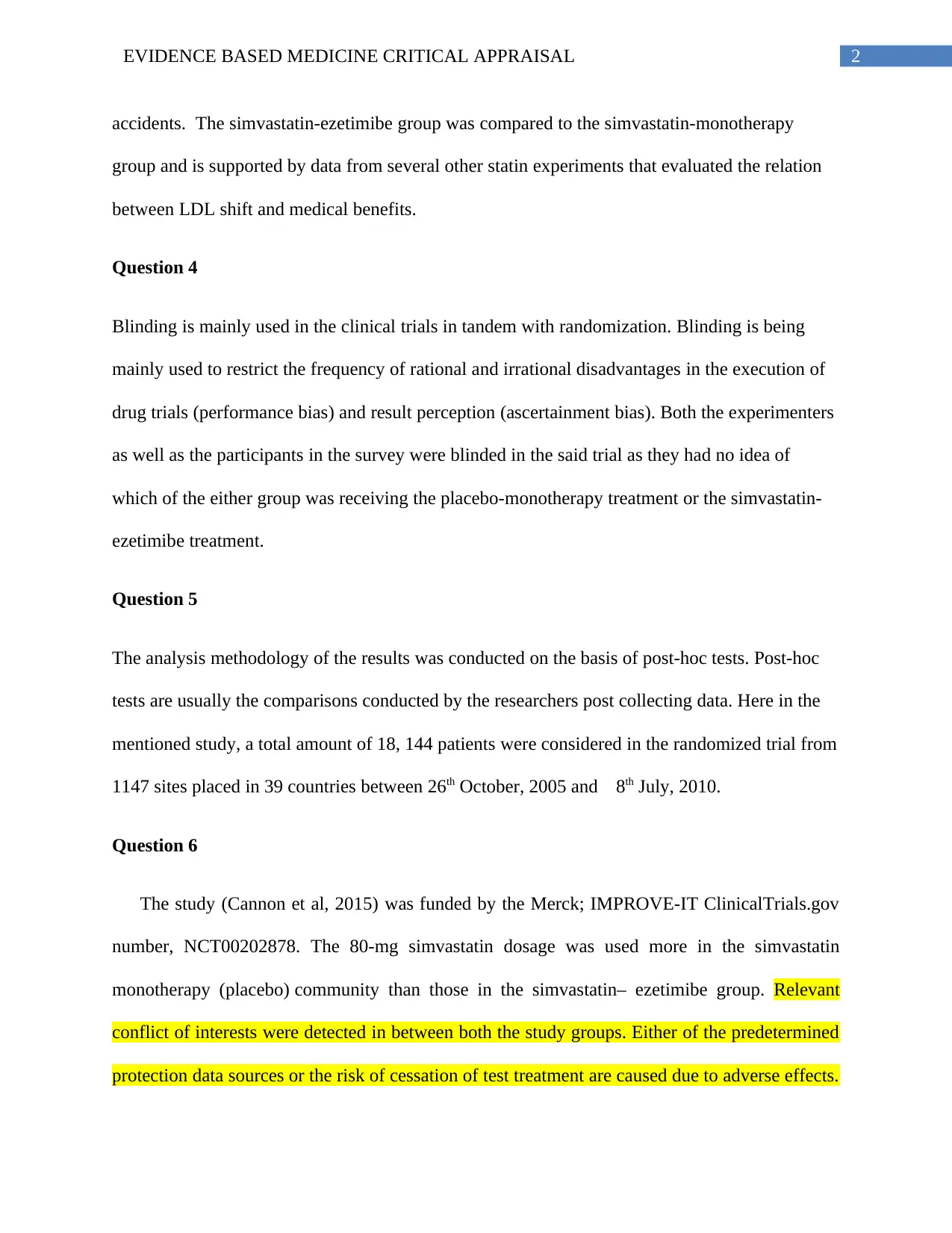
2EVIDENCE BASED MEDICINE CRITICAL APPRAISAL
accidents. The simvastatin-ezetimibe group was compared to the simvastatin-monotherapy
group and is supported by data from several other statin experiments that evaluated the relation
between LDL shift and medical benefits.
Question 4
Blinding is mainly used in the clinical trials in tandem with randomization. Blinding is being
mainly used to restrict the frequency of rational and irrational disadvantages in the execution of
drug trials (performance bias) and result perception (ascertainment bias). Both the experimenters
as well as the participants in the survey were blinded in the said trial as they had no idea of
which of the either group was receiving the placebo-monotherapy treatment or the simvastatin-
ezetimibe treatment.
Question 5
The analysis methodology of the results was conducted on the basis of post-hoc tests. Post-hoc
tests are usually the comparisons conducted by the researchers post collecting data. Here in the
mentioned study, a total amount of 18, 144 patients were considered in the randomized trial from
1147 sites placed in 39 countries between 26th October, 2005 and 8th July, 2010.
Question 6
The study (Cannon et al, 2015) was funded by the Merck; IMPROVE-IT ClinicalTrials.gov
number, NCT00202878. The 80-mg simvastatin dosage was used more in the simvastatin
monotherapy (placebo) community than those in the simvastatin– ezetimibe group. Relevant
conflict of interests were detected in between both the study groups. Either of the predetermined
protection data sources or the risk of cessation of test treatment are caused due to adverse effects.
accidents. The simvastatin-ezetimibe group was compared to the simvastatin-monotherapy
group and is supported by data from several other statin experiments that evaluated the relation
between LDL shift and medical benefits.
Question 4
Blinding is mainly used in the clinical trials in tandem with randomization. Blinding is being
mainly used to restrict the frequency of rational and irrational disadvantages in the execution of
drug trials (performance bias) and result perception (ascertainment bias). Both the experimenters
as well as the participants in the survey were blinded in the said trial as they had no idea of
which of the either group was receiving the placebo-monotherapy treatment or the simvastatin-
ezetimibe treatment.
Question 5
The analysis methodology of the results was conducted on the basis of post-hoc tests. Post-hoc
tests are usually the comparisons conducted by the researchers post collecting data. Here in the
mentioned study, a total amount of 18, 144 patients were considered in the randomized trial from
1147 sites placed in 39 countries between 26th October, 2005 and 8th July, 2010.
Question 6
The study (Cannon et al, 2015) was funded by the Merck; IMPROVE-IT ClinicalTrials.gov
number, NCT00202878. The 80-mg simvastatin dosage was used more in the simvastatin
monotherapy (placebo) community than those in the simvastatin– ezetimibe group. Relevant
conflict of interests were detected in between both the study groups. Either of the predetermined
protection data sources or the risk of cessation of test treatment are caused due to adverse effects.
⊘ This is a preview!⊘
Do you want full access?
Subscribe today to unlock all pages.

Trusted by 1+ million students worldwide
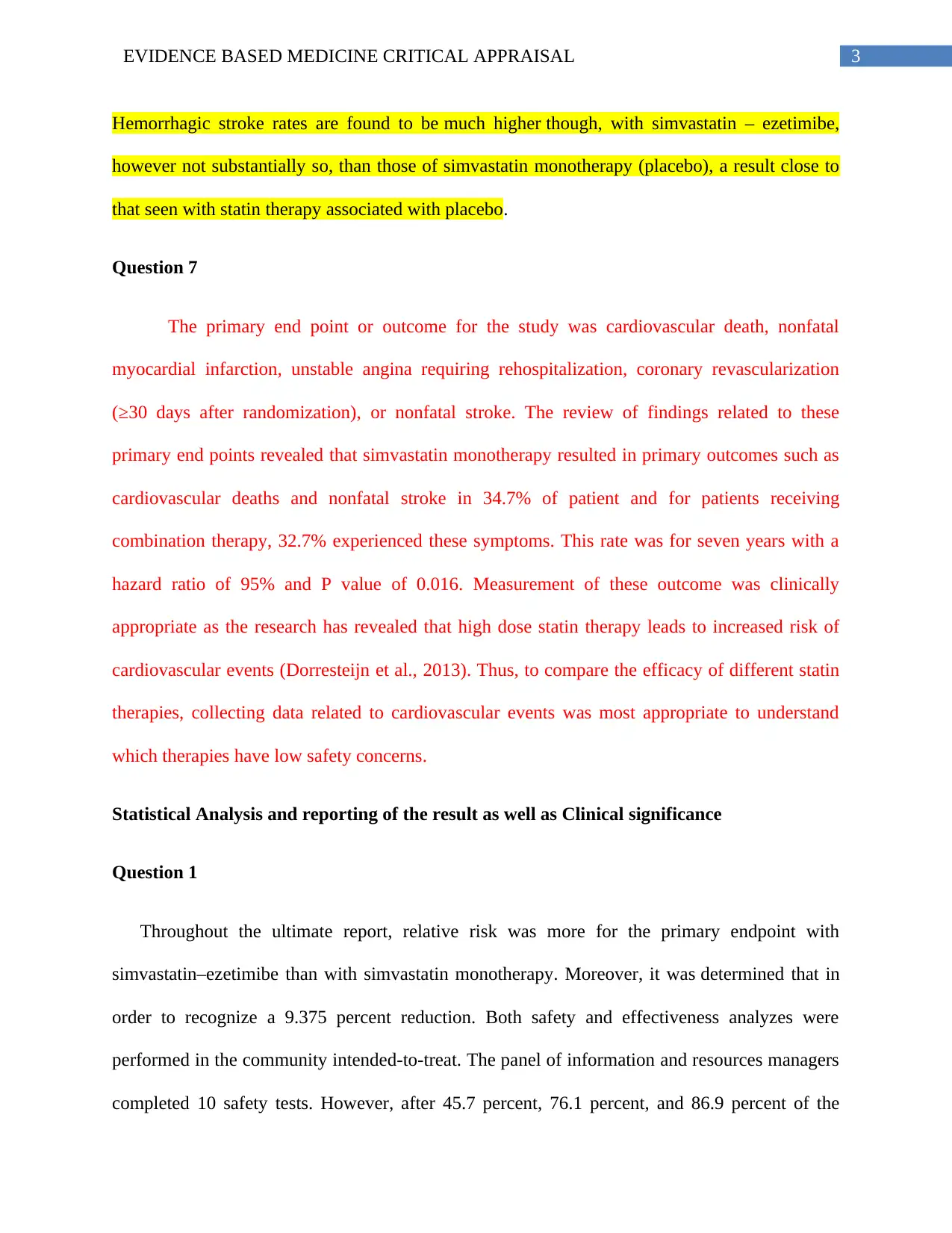
3EVIDENCE BASED MEDICINE CRITICAL APPRAISAL
Hemorrhagic stroke rates are found to be much higher though, with simvastatin – ezetimibe,
however not substantially so, than those of simvastatin monotherapy (placebo), a result close to
that seen with statin therapy associated with placebo.
Question 7
The primary end point or outcome for the study was cardiovascular death, nonfatal
myocardial infarction, unstable angina requiring rehospitalization, coronary revascularization
(≥30 days after randomization), or nonfatal stroke. The review of findings related to these
primary end points revealed that simvastatin monotherapy resulted in primary outcomes such as
cardiovascular deaths and nonfatal stroke in 34.7% of patient and for patients receiving
combination therapy, 32.7% experienced these symptoms. This rate was for seven years with a
hazard ratio of 95% and P value of 0.016. Measurement of these outcome was clinically
appropriate as the research has revealed that high dose statin therapy leads to increased risk of
cardiovascular events (Dorresteijn et al., 2013). Thus, to compare the efficacy of different statin
therapies, collecting data related to cardiovascular events was most appropriate to understand
which therapies have low safety concerns.
Statistical Analysis and reporting of the result as well as Clinical significance
Question 1
Throughout the ultimate report, relative risk was more for the primary endpoint with
simvastatin–ezetimibe than with simvastatin monotherapy. Moreover, it was determined that in
order to recognize a 9.375 percent reduction. Both safety and effectiveness analyzes were
performed in the community intended-to-treat. The panel of information and resources managers
completed 10 safety tests. However, after 45.7 percent, 76.1 percent, and 86.9 percent of the
Hemorrhagic stroke rates are found to be much higher though, with simvastatin – ezetimibe,
however not substantially so, than those of simvastatin monotherapy (placebo), a result close to
that seen with statin therapy associated with placebo.
Question 7
The primary end point or outcome for the study was cardiovascular death, nonfatal
myocardial infarction, unstable angina requiring rehospitalization, coronary revascularization
(≥30 days after randomization), or nonfatal stroke. The review of findings related to these
primary end points revealed that simvastatin monotherapy resulted in primary outcomes such as
cardiovascular deaths and nonfatal stroke in 34.7% of patient and for patients receiving
combination therapy, 32.7% experienced these symptoms. This rate was for seven years with a
hazard ratio of 95% and P value of 0.016. Measurement of these outcome was clinically
appropriate as the research has revealed that high dose statin therapy leads to increased risk of
cardiovascular events (Dorresteijn et al., 2013). Thus, to compare the efficacy of different statin
therapies, collecting data related to cardiovascular events was most appropriate to understand
which therapies have low safety concerns.
Statistical Analysis and reporting of the result as well as Clinical significance
Question 1
Throughout the ultimate report, relative risk was more for the primary endpoint with
simvastatin–ezetimibe than with simvastatin monotherapy. Moreover, it was determined that in
order to recognize a 9.375 percent reduction. Both safety and effectiveness analyzes were
performed in the community intended-to-treat. The panel of information and resources managers
completed 10 safety tests. However, after 45.7 percent, 76.1 percent, and 86.9 percent of the
Paraphrase This Document
Need a fresh take? Get an instant paraphrase of this document with our AI Paraphraser
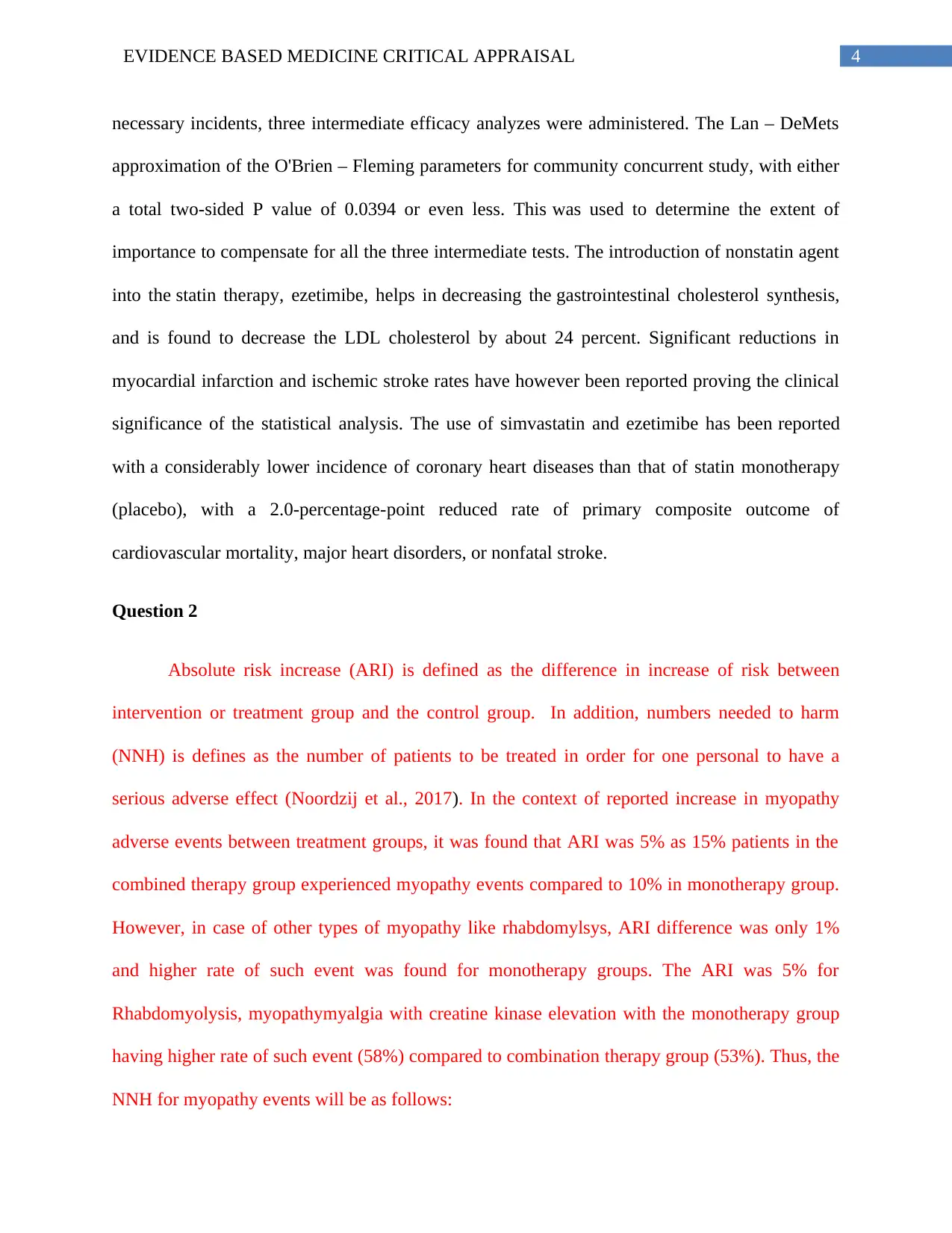
4EVIDENCE BASED MEDICINE CRITICAL APPRAISAL
necessary incidents, three intermediate efficacy analyzes were administered. The Lan – DeMets
approximation of the O'Brien – Fleming parameters for community concurrent study, with either
a total two-sided P value of 0.0394 or even less. This was used to determine the extent of
importance to compensate for all the three intermediate tests. The introduction of nonstatin agent
into the statin therapy, ezetimibe, helps in decreasing the gastrointestinal cholesterol synthesis,
and is found to decrease the LDL cholesterol by about 24 percent. Significant reductions in
myocardial infarction and ischemic stroke rates have however been reported proving the clinical
significance of the statistical analysis. The use of simvastatin and ezetimibe has been reported
with a considerably lower incidence of coronary heart diseases than that of statin monotherapy
(placebo), with a 2.0-percentage-point reduced rate of primary composite outcome of
cardiovascular mortality, major heart disorders, or nonfatal stroke.
Question 2
Absolute risk increase (ARI) is defined as the difference in increase of risk between
intervention or treatment group and the control group. In addition, numbers needed to harm
(NNH) is defines as the number of patients to be treated in order for one personal to have a
serious adverse effect (Noordzij et al., 2017). In the context of reported increase in myopathy
adverse events between treatment groups, it was found that ARI was 5% as 15% patients in the
combined therapy group experienced myopathy events compared to 10% in monotherapy group.
However, in case of other types of myopathy like rhabdomylsys, ARI difference was only 1%
and higher rate of such event was found for monotherapy groups. The ARI was 5% for
Rhabdomyolysis, myopathymyalgia with creatine kinase elevation with the monotherapy group
having higher rate of such event (58%) compared to combination therapy group (53%). Thus, the
NNH for myopathy events will be as follows:
necessary incidents, three intermediate efficacy analyzes were administered. The Lan – DeMets
approximation of the O'Brien – Fleming parameters for community concurrent study, with either
a total two-sided P value of 0.0394 or even less. This was used to determine the extent of
importance to compensate for all the three intermediate tests. The introduction of nonstatin agent
into the statin therapy, ezetimibe, helps in decreasing the gastrointestinal cholesterol synthesis,
and is found to decrease the LDL cholesterol by about 24 percent. Significant reductions in
myocardial infarction and ischemic stroke rates have however been reported proving the clinical
significance of the statistical analysis. The use of simvastatin and ezetimibe has been reported
with a considerably lower incidence of coronary heart diseases than that of statin monotherapy
(placebo), with a 2.0-percentage-point reduced rate of primary composite outcome of
cardiovascular mortality, major heart disorders, or nonfatal stroke.
Question 2
Absolute risk increase (ARI) is defined as the difference in increase of risk between
intervention or treatment group and the control group. In addition, numbers needed to harm
(NNH) is defines as the number of patients to be treated in order for one personal to have a
serious adverse effect (Noordzij et al., 2017). In the context of reported increase in myopathy
adverse events between treatment groups, it was found that ARI was 5% as 15% patients in the
combined therapy group experienced myopathy events compared to 10% in monotherapy group.
However, in case of other types of myopathy like rhabdomylsys, ARI difference was only 1%
and higher rate of such event was found for monotherapy groups. The ARI was 5% for
Rhabdomyolysis, myopathymyalgia with creatine kinase elevation with the monotherapy group
having higher rate of such event (58%) compared to combination therapy group (53%). Thus, the
NNH for myopathy events will be as follows:
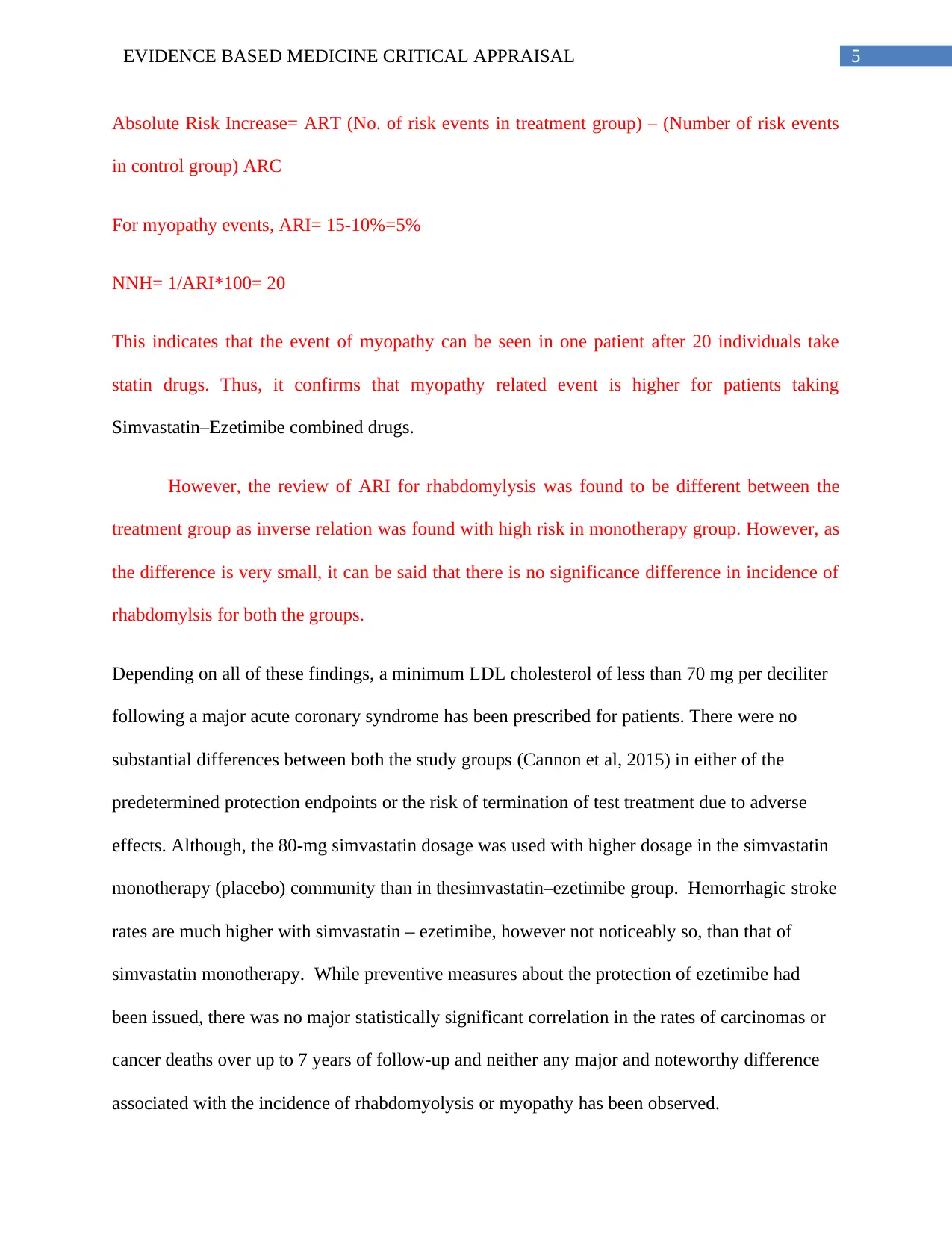
5EVIDENCE BASED MEDICINE CRITICAL APPRAISAL
Absolute Risk Increase= ART (No. of risk events in treatment group) – (Number of risk events
in control group) ARC
For myopathy events, ARI= 15-10%=5%
NNH= 1/ARI*100= 20
This indicates that the event of myopathy can be seen in one patient after 20 individuals take
statin drugs. Thus, it confirms that myopathy related event is higher for patients taking
Simvastatin–Ezetimibe combined drugs.
However, the review of ARI for rhabdomylysis was found to be different between the
treatment group as inverse relation was found with high risk in monotherapy group. However, as
the difference is very small, it can be said that there is no significance difference in incidence of
rhabdomylsis for both the groups.
Depending on all of these findings, a minimum LDL cholesterol of less than 70 mg per deciliter
following a major acute coronary syndrome has been prescribed for patients. There were no
substantial differences between both the study groups (Cannon et al, 2015) in either of the
predetermined protection endpoints or the risk of termination of test treatment due to adverse
effects. Although, the 80-mg simvastatin dosage was used with higher dosage in the simvastatin
monotherapy (placebo) community than in thesimvastatin–ezetimibe group. Hemorrhagic stroke
rates are much higher with simvastatin – ezetimibe, however not noticeably so, than that of
simvastatin monotherapy. While preventive measures about the protection of ezetimibe had
been issued, there was no major statistically significant correlation in the rates of carcinomas or
cancer deaths over up to 7 years of follow-up and neither any major and noteworthy difference
associated with the incidence of rhabdomyolysis or myopathy has been observed.
Absolute Risk Increase= ART (No. of risk events in treatment group) – (Number of risk events
in control group) ARC
For myopathy events, ARI= 15-10%=5%
NNH= 1/ARI*100= 20
This indicates that the event of myopathy can be seen in one patient after 20 individuals take
statin drugs. Thus, it confirms that myopathy related event is higher for patients taking
Simvastatin–Ezetimibe combined drugs.
However, the review of ARI for rhabdomylysis was found to be different between the
treatment group as inverse relation was found with high risk in monotherapy group. However, as
the difference is very small, it can be said that there is no significance difference in incidence of
rhabdomylsis for both the groups.
Depending on all of these findings, a minimum LDL cholesterol of less than 70 mg per deciliter
following a major acute coronary syndrome has been prescribed for patients. There were no
substantial differences between both the study groups (Cannon et al, 2015) in either of the
predetermined protection endpoints or the risk of termination of test treatment due to adverse
effects. Although, the 80-mg simvastatin dosage was used with higher dosage in the simvastatin
monotherapy (placebo) community than in thesimvastatin–ezetimibe group. Hemorrhagic stroke
rates are much higher with simvastatin – ezetimibe, however not noticeably so, than that of
simvastatin monotherapy. While preventive measures about the protection of ezetimibe had
been issued, there was no major statistically significant correlation in the rates of carcinomas or
cancer deaths over up to 7 years of follow-up and neither any major and noteworthy difference
associated with the incidence of rhabdomyolysis or myopathy has been observed.
⊘ This is a preview!⊘
Do you want full access?
Subscribe today to unlock all pages.

Trusted by 1+ million students worldwide
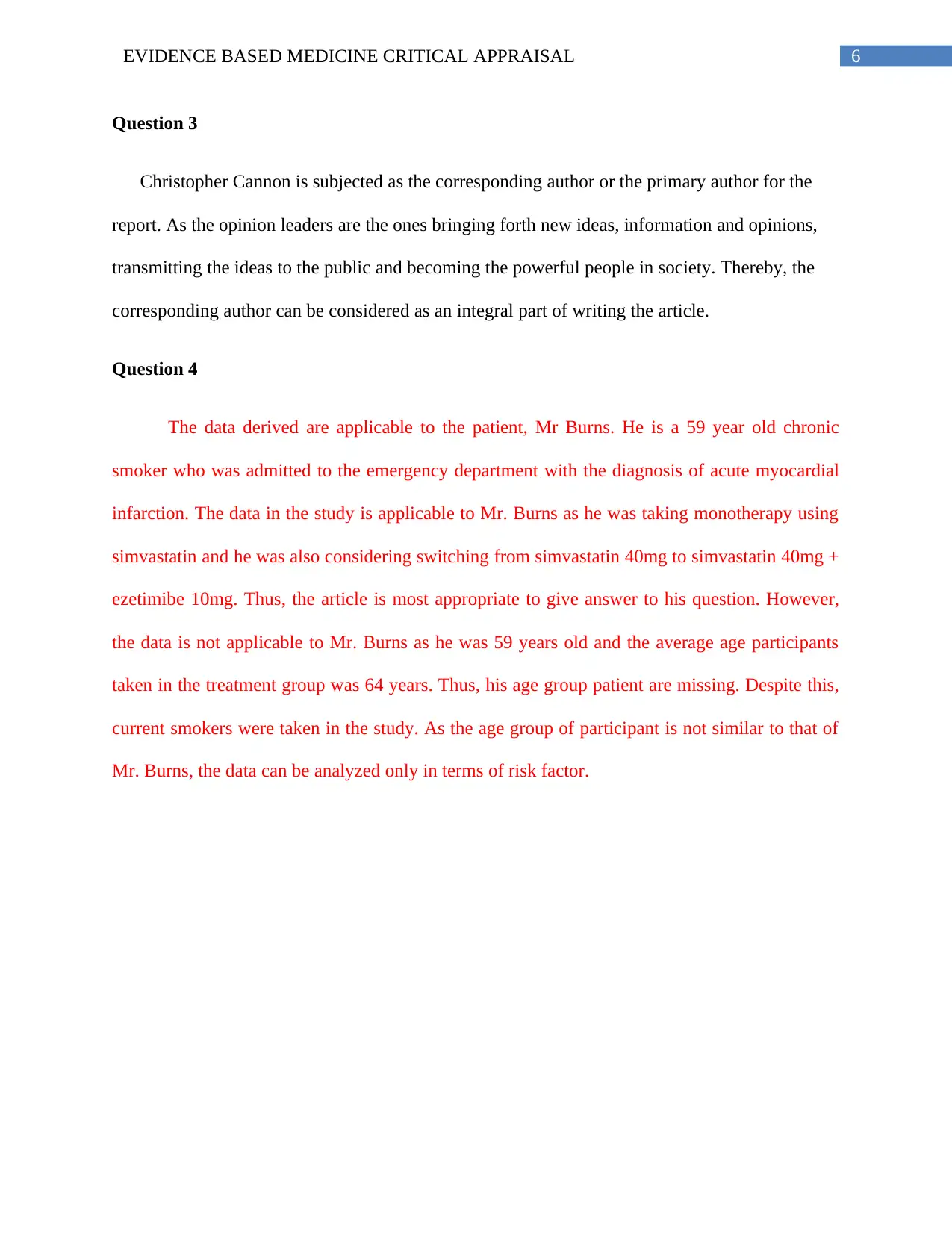
6EVIDENCE BASED MEDICINE CRITICAL APPRAISAL
Question 3
Christopher Cannon is subjected as the corresponding author or the primary author for the
report. As the opinion leaders are the ones bringing forth new ideas, information and opinions,
transmitting the ideas to the public and becoming the powerful people in society. Thereby, the
corresponding author can be considered as an integral part of writing the article.
Question 4
The data derived are applicable to the patient, Mr Burns. He is a 59 year old chronic
smoker who was admitted to the emergency department with the diagnosis of acute myocardial
infarction. The data in the study is applicable to Mr. Burns as he was taking monotherapy using
simvastatin and he was also considering switching from simvastatin 40mg to simvastatin 40mg +
ezetimibe 10mg. Thus, the article is most appropriate to give answer to his question. However,
the data is not applicable to Mr. Burns as he was 59 years old and the average age participants
taken in the treatment group was 64 years. Thus, his age group patient are missing. Despite this,
current smokers were taken in the study. As the age group of participant is not similar to that of
Mr. Burns, the data can be analyzed only in terms of risk factor.
Question 3
Christopher Cannon is subjected as the corresponding author or the primary author for the
report. As the opinion leaders are the ones bringing forth new ideas, information and opinions,
transmitting the ideas to the public and becoming the powerful people in society. Thereby, the
corresponding author can be considered as an integral part of writing the article.
Question 4
The data derived are applicable to the patient, Mr Burns. He is a 59 year old chronic
smoker who was admitted to the emergency department with the diagnosis of acute myocardial
infarction. The data in the study is applicable to Mr. Burns as he was taking monotherapy using
simvastatin and he was also considering switching from simvastatin 40mg to simvastatin 40mg +
ezetimibe 10mg. Thus, the article is most appropriate to give answer to his question. However,
the data is not applicable to Mr. Burns as he was 59 years old and the average age participants
taken in the treatment group was 64 years. Thus, his age group patient are missing. Despite this,
current smokers were taken in the study. As the age group of participant is not similar to that of
Mr. Burns, the data can be analyzed only in terms of risk factor.
Paraphrase This Document
Need a fresh take? Get an instant paraphrase of this document with our AI Paraphraser
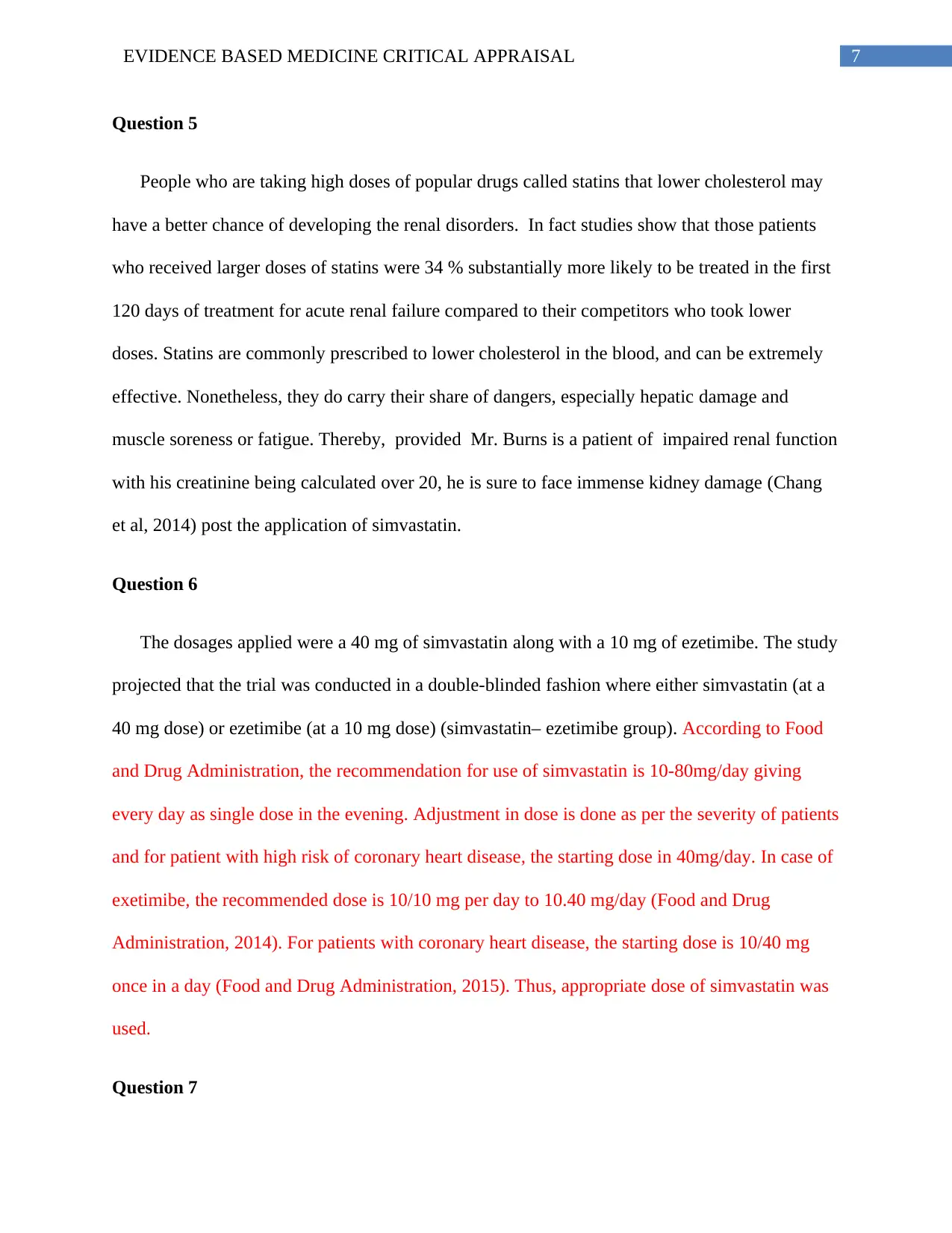
7EVIDENCE BASED MEDICINE CRITICAL APPRAISAL
Question 5
People who are taking high doses of popular drugs called statins that lower cholesterol may
have a better chance of developing the renal disorders. In fact studies show that those patients
who received larger doses of statins were 34 % substantially more likely to be treated in the first
120 days of treatment for acute renal failure compared to their competitors who took lower
doses. Statins are commonly prescribed to lower cholesterol in the blood, and can be extremely
effective. Nonetheless, they do carry their share of dangers, especially hepatic damage and
muscle soreness or fatigue. Thereby, provided Mr. Burns is a patient of impaired renal function
with his creatinine being calculated over 20, he is sure to face immense kidney damage (Chang
et al, 2014) post the application of simvastatin.
Question 6
The dosages applied were a 40 mg of simvastatin along with a 10 mg of ezetimibe. The study
projected that the trial was conducted in a double-blinded fashion where either simvastatin (at a
40 mg dose) or ezetimibe (at a 10 mg dose) (simvastatin– ezetimibe group). According to Food
and Drug Administration, the recommendation for use of simvastatin is 10-80mg/day giving
every day as single dose in the evening. Adjustment in dose is done as per the severity of patients
and for patient with high risk of coronary heart disease, the starting dose in 40mg/day. In case of
exetimibe, the recommended dose is 10/10 mg per day to 10.40 mg/day (Food and Drug
Administration, 2014). For patients with coronary heart disease, the starting dose is 10/40 mg
once in a day (Food and Drug Administration, 2015). Thus, appropriate dose of simvastatin was
used.
Question 7
Question 5
People who are taking high doses of popular drugs called statins that lower cholesterol may
have a better chance of developing the renal disorders. In fact studies show that those patients
who received larger doses of statins were 34 % substantially more likely to be treated in the first
120 days of treatment for acute renal failure compared to their competitors who took lower
doses. Statins are commonly prescribed to lower cholesterol in the blood, and can be extremely
effective. Nonetheless, they do carry their share of dangers, especially hepatic damage and
muscle soreness or fatigue. Thereby, provided Mr. Burns is a patient of impaired renal function
with his creatinine being calculated over 20, he is sure to face immense kidney damage (Chang
et al, 2014) post the application of simvastatin.
Question 6
The dosages applied were a 40 mg of simvastatin along with a 10 mg of ezetimibe. The study
projected that the trial was conducted in a double-blinded fashion where either simvastatin (at a
40 mg dose) or ezetimibe (at a 10 mg dose) (simvastatin– ezetimibe group). According to Food
and Drug Administration, the recommendation for use of simvastatin is 10-80mg/day giving
every day as single dose in the evening. Adjustment in dose is done as per the severity of patients
and for patient with high risk of coronary heart disease, the starting dose in 40mg/day. In case of
exetimibe, the recommended dose is 10/10 mg per day to 10.40 mg/day (Food and Drug
Administration, 2014). For patients with coronary heart disease, the starting dose is 10/40 mg
once in a day (Food and Drug Administration, 2015). Thus, appropriate dose of simvastatin was
used.
Question 7
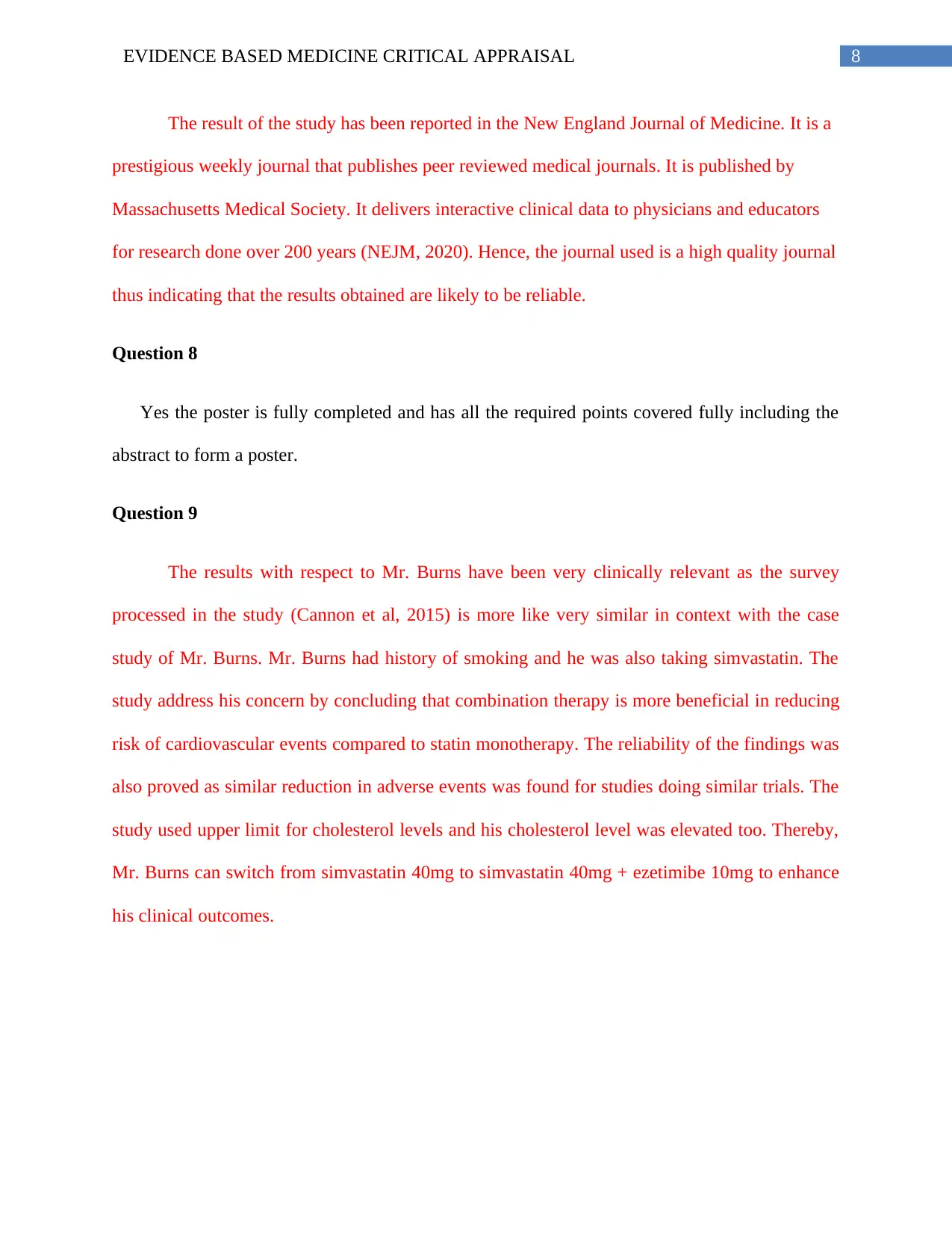
8EVIDENCE BASED MEDICINE CRITICAL APPRAISAL
The result of the study has been reported in the New England Journal of Medicine. It is a
prestigious weekly journal that publishes peer reviewed medical journals. It is published by
Massachusetts Medical Society. It delivers interactive clinical data to physicians and educators
for research done over 200 years (NEJM, 2020). Hence, the journal used is a high quality journal
thus indicating that the results obtained are likely to be reliable.
Question 8
Yes the poster is fully completed and has all the required points covered fully including the
abstract to form a poster.
Question 9
The results with respect to Mr. Burns have been very clinically relevant as the survey
processed in the study (Cannon et al, 2015) is more like very similar in context with the case
study of Mr. Burns. Mr. Burns had history of smoking and he was also taking simvastatin. The
study address his concern by concluding that combination therapy is more beneficial in reducing
risk of cardiovascular events compared to statin monotherapy. The reliability of the findings was
also proved as similar reduction in adverse events was found for studies doing similar trials. The
study used upper limit for cholesterol levels and his cholesterol level was elevated too. Thereby,
Mr. Burns can switch from simvastatin 40mg to simvastatin 40mg + ezetimibe 10mg to enhance
his clinical outcomes.
The result of the study has been reported in the New England Journal of Medicine. It is a
prestigious weekly journal that publishes peer reviewed medical journals. It is published by
Massachusetts Medical Society. It delivers interactive clinical data to physicians and educators
for research done over 200 years (NEJM, 2020). Hence, the journal used is a high quality journal
thus indicating that the results obtained are likely to be reliable.
Question 8
Yes the poster is fully completed and has all the required points covered fully including the
abstract to form a poster.
Question 9
The results with respect to Mr. Burns have been very clinically relevant as the survey
processed in the study (Cannon et al, 2015) is more like very similar in context with the case
study of Mr. Burns. Mr. Burns had history of smoking and he was also taking simvastatin. The
study address his concern by concluding that combination therapy is more beneficial in reducing
risk of cardiovascular events compared to statin monotherapy. The reliability of the findings was
also proved as similar reduction in adverse events was found for studies doing similar trials. The
study used upper limit for cholesterol levels and his cholesterol level was elevated too. Thereby,
Mr. Burns can switch from simvastatin 40mg to simvastatin 40mg + ezetimibe 10mg to enhance
his clinical outcomes.
⊘ This is a preview!⊘
Do you want full access?
Subscribe today to unlock all pages.

Trusted by 1+ million students worldwide
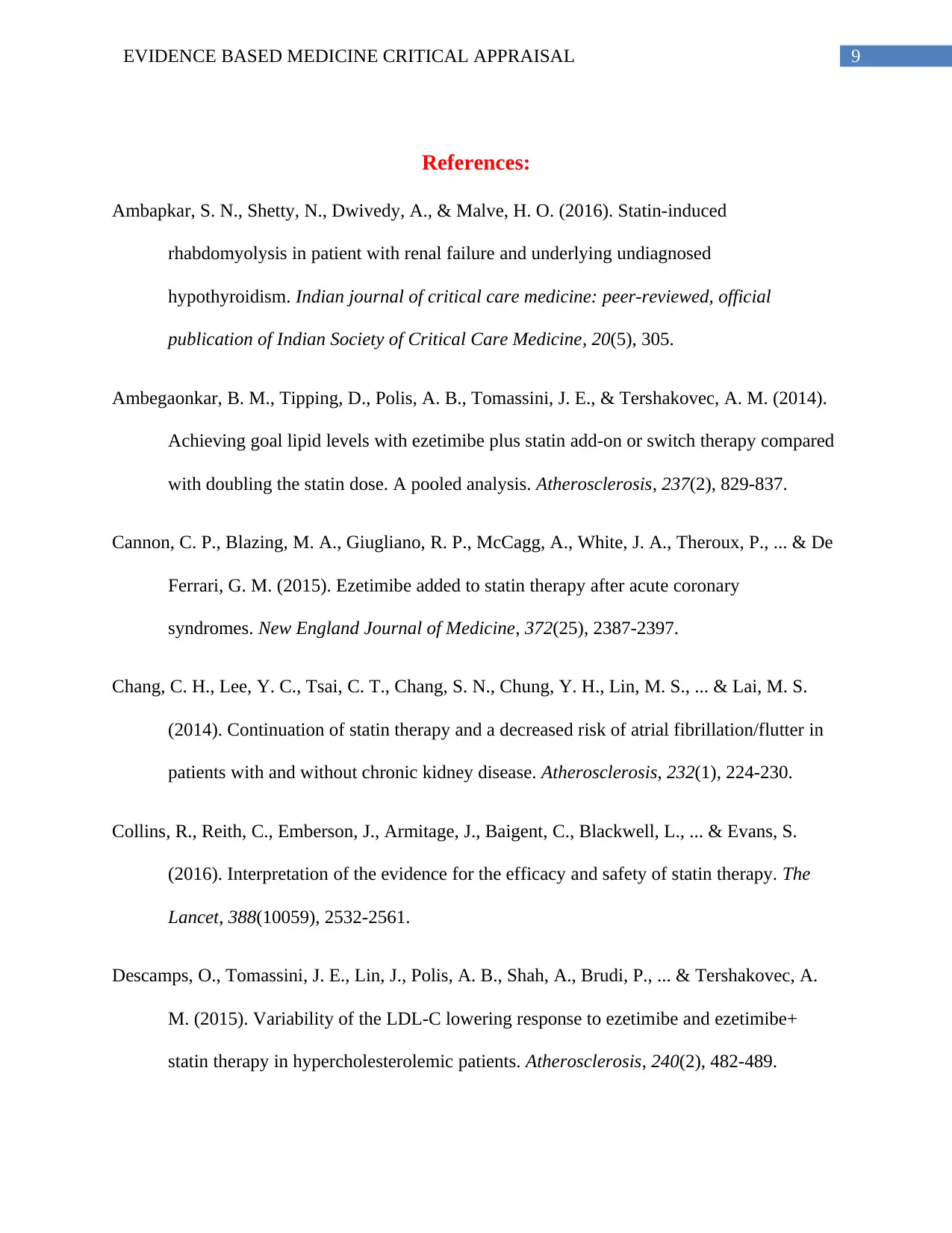
9EVIDENCE BASED MEDICINE CRITICAL APPRAISAL
References:
Ambapkar, S. N., Shetty, N., Dwivedy, A., & Malve, H. O. (2016). Statin-induced
rhabdomyolysis in patient with renal failure and underlying undiagnosed
hypothyroidism. Indian journal of critical care medicine: peer-reviewed, official
publication of Indian Society of Critical Care Medicine, 20(5), 305.
Ambegaonkar, B. M., Tipping, D., Polis, A. B., Tomassini, J. E., & Tershakovec, A. M. (2014).
Achieving goal lipid levels with ezetimibe plus statin add-on or switch therapy compared
with doubling the statin dose. A pooled analysis. Atherosclerosis, 237(2), 829-837.
Cannon, C. P., Blazing, M. A., Giugliano, R. P., McCagg, A., White, J. A., Theroux, P., ... & De
Ferrari, G. M. (2015). Ezetimibe added to statin therapy after acute coronary
syndromes. New England Journal of Medicine, 372(25), 2387-2397.
Chang, C. H., Lee, Y. C., Tsai, C. T., Chang, S. N., Chung, Y. H., Lin, M. S., ... & Lai, M. S.
(2014). Continuation of statin therapy and a decreased risk of atrial fibrillation/flutter in
patients with and without chronic kidney disease. Atherosclerosis, 232(1), 224-230.
Collins, R., Reith, C., Emberson, J., Armitage, J., Baigent, C., Blackwell, L., ... & Evans, S.
(2016). Interpretation of the evidence for the efficacy and safety of statin therapy. The
Lancet, 388(10059), 2532-2561.
Descamps, O., Tomassini, J. E., Lin, J., Polis, A. B., Shah, A., Brudi, P., ... & Tershakovec, A.
M. (2015). Variability of the LDL-C lowering response to ezetimibe and ezetimibe+
statin therapy in hypercholesterolemic patients. Atherosclerosis, 240(2), 482-489.
References:
Ambapkar, S. N., Shetty, N., Dwivedy, A., & Malve, H. O. (2016). Statin-induced
rhabdomyolysis in patient with renal failure and underlying undiagnosed
hypothyroidism. Indian journal of critical care medicine: peer-reviewed, official
publication of Indian Society of Critical Care Medicine, 20(5), 305.
Ambegaonkar, B. M., Tipping, D., Polis, A. B., Tomassini, J. E., & Tershakovec, A. M. (2014).
Achieving goal lipid levels with ezetimibe plus statin add-on or switch therapy compared
with doubling the statin dose. A pooled analysis. Atherosclerosis, 237(2), 829-837.
Cannon, C. P., Blazing, M. A., Giugliano, R. P., McCagg, A., White, J. A., Theroux, P., ... & De
Ferrari, G. M. (2015). Ezetimibe added to statin therapy after acute coronary
syndromes. New England Journal of Medicine, 372(25), 2387-2397.
Chang, C. H., Lee, Y. C., Tsai, C. T., Chang, S. N., Chung, Y. H., Lin, M. S., ... & Lai, M. S.
(2014). Continuation of statin therapy and a decreased risk of atrial fibrillation/flutter in
patients with and without chronic kidney disease. Atherosclerosis, 232(1), 224-230.
Collins, R., Reith, C., Emberson, J., Armitage, J., Baigent, C., Blackwell, L., ... & Evans, S.
(2016). Interpretation of the evidence for the efficacy and safety of statin therapy. The
Lancet, 388(10059), 2532-2561.
Descamps, O., Tomassini, J. E., Lin, J., Polis, A. B., Shah, A., Brudi, P., ... & Tershakovec, A.
M. (2015). Variability of the LDL-C lowering response to ezetimibe and ezetimibe+
statin therapy in hypercholesterolemic patients. Atherosclerosis, 240(2), 482-489.
Paraphrase This Document
Need a fresh take? Get an instant paraphrase of this document with our AI Paraphraser
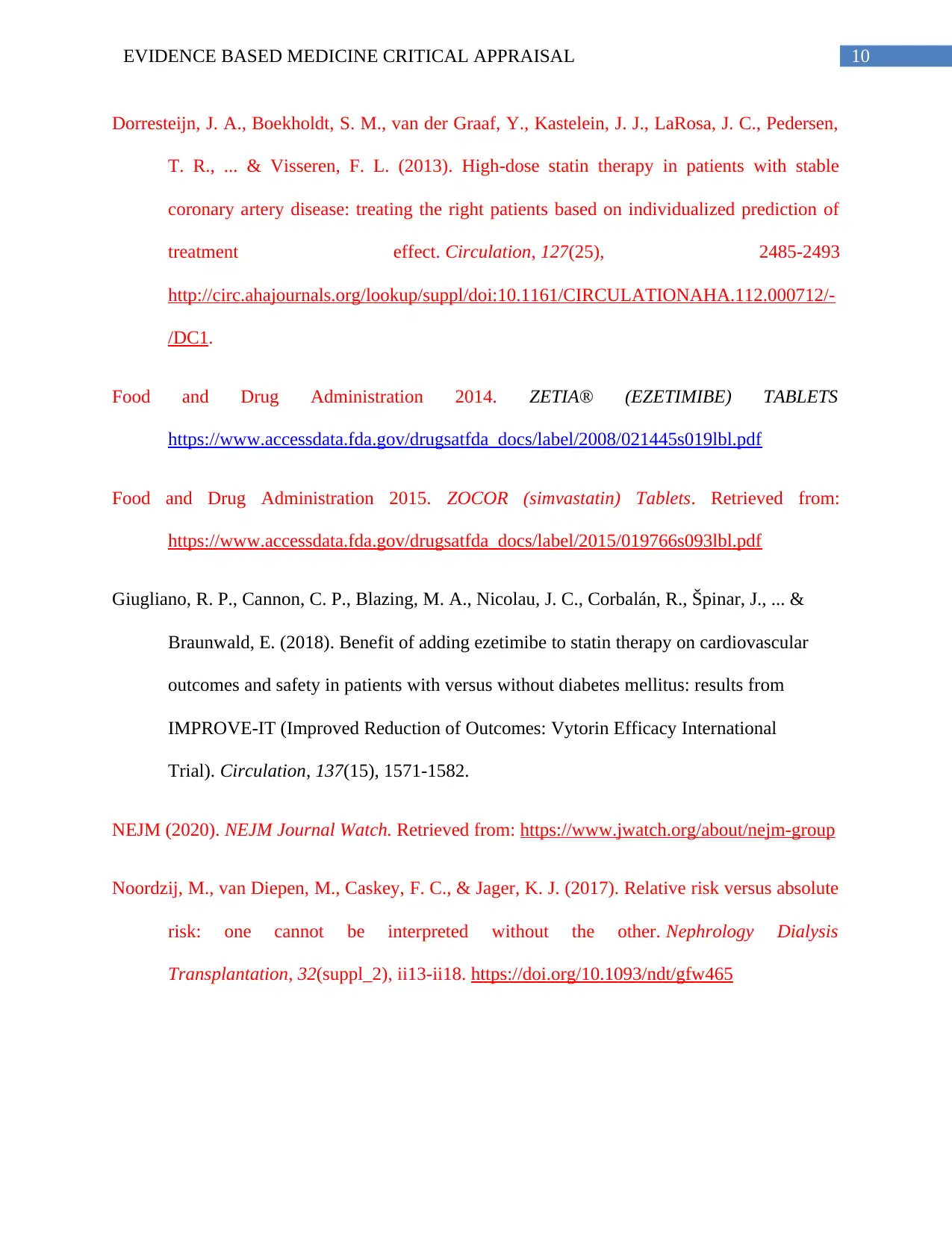
10EVIDENCE BASED MEDICINE CRITICAL APPRAISAL
Dorresteijn, J. A., Boekholdt, S. M., van der Graaf, Y., Kastelein, J. J., LaRosa, J. C., Pedersen,
T. R., ... & Visseren, F. L. (2013). High-dose statin therapy in patients with stable
coronary artery disease: treating the right patients based on individualized prediction of
treatment effect. Circulation, 127(25), 2485-2493
http://circ.ahajournals.org/lookup/suppl/doi:10.1161/CIRCULATIONAHA.112.000712/-
/DC1.
Food and Drug Administration 2014. ZETIA® (EZETIMIBE) TABLETS
https://www.accessdata.fda.gov/drugsatfda_docs/label/2008/021445s019lbl.pdf
Food and Drug Administration 2015. ZOCOR (simvastatin) Tablets. Retrieved from:
https://www.accessdata.fda.gov/drugsatfda_docs/label/2015/019766s093lbl.pdf
Giugliano, R. P., Cannon, C. P., Blazing, M. A., Nicolau, J. C., Corbalán, R., Špinar, J., ... &
Braunwald, E. (2018). Benefit of adding ezetimibe to statin therapy on cardiovascular
outcomes and safety in patients with versus without diabetes mellitus: results from
IMPROVE-IT (Improved Reduction of Outcomes: Vytorin Efficacy International
Trial). Circulation, 137(15), 1571-1582.
NEJM (2020). NEJM Journal Watch. Retrieved from: https://www.jwatch.org/about/nejm-group
Noordzij, M., van Diepen, M., Caskey, F. C., & Jager, K. J. (2017). Relative risk versus absolute
risk: one cannot be interpreted without the other. Nephrology Dialysis
Transplantation, 32(suppl_2), ii13-ii18. https://doi.org/10.1093/ndt/gfw465
Dorresteijn, J. A., Boekholdt, S. M., van der Graaf, Y., Kastelein, J. J., LaRosa, J. C., Pedersen,
T. R., ... & Visseren, F. L. (2013). High-dose statin therapy in patients with stable
coronary artery disease: treating the right patients based on individualized prediction of
treatment effect. Circulation, 127(25), 2485-2493
http://circ.ahajournals.org/lookup/suppl/doi:10.1161/CIRCULATIONAHA.112.000712/-
/DC1.
Food and Drug Administration 2014. ZETIA® (EZETIMIBE) TABLETS
https://www.accessdata.fda.gov/drugsatfda_docs/label/2008/021445s019lbl.pdf
Food and Drug Administration 2015. ZOCOR (simvastatin) Tablets. Retrieved from:
https://www.accessdata.fda.gov/drugsatfda_docs/label/2015/019766s093lbl.pdf
Giugliano, R. P., Cannon, C. P., Blazing, M. A., Nicolau, J. C., Corbalán, R., Špinar, J., ... &
Braunwald, E. (2018). Benefit of adding ezetimibe to statin therapy on cardiovascular
outcomes and safety in patients with versus without diabetes mellitus: results from
IMPROVE-IT (Improved Reduction of Outcomes: Vytorin Efficacy International
Trial). Circulation, 137(15), 1571-1582.
NEJM (2020). NEJM Journal Watch. Retrieved from: https://www.jwatch.org/about/nejm-group
Noordzij, M., van Diepen, M., Caskey, F. C., & Jager, K. J. (2017). Relative risk versus absolute
risk: one cannot be interpreted without the other. Nephrology Dialysis
Transplantation, 32(suppl_2), ii13-ii18. https://doi.org/10.1093/ndt/gfw465
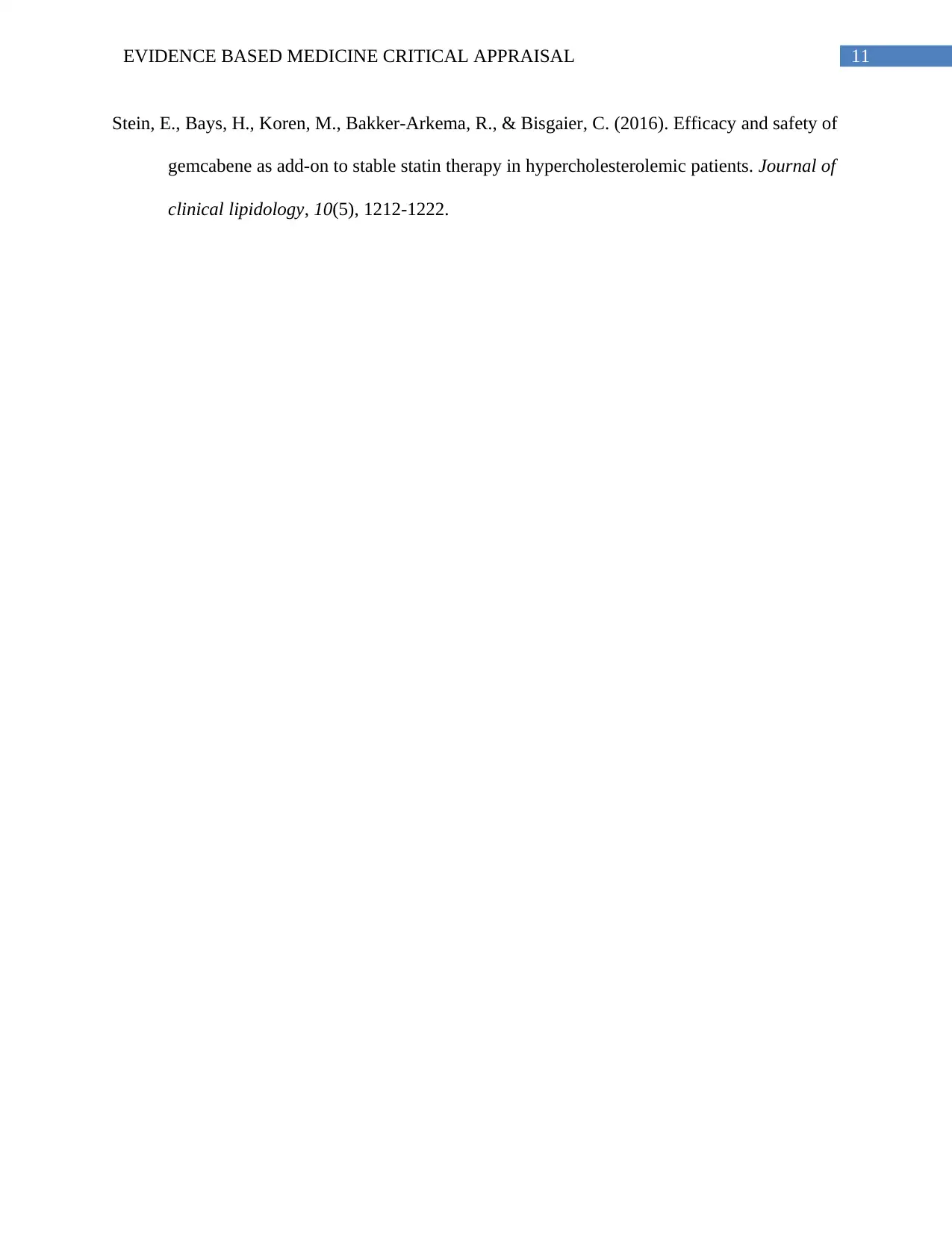
11EVIDENCE BASED MEDICINE CRITICAL APPRAISAL
Stein, E., Bays, H., Koren, M., Bakker-Arkema, R., & Bisgaier, C. (2016). Efficacy and safety of
gemcabene as add-on to stable statin therapy in hypercholesterolemic patients. Journal of
clinical lipidology, 10(5), 1212-1222.
Stein, E., Bays, H., Koren, M., Bakker-Arkema, R., & Bisgaier, C. (2016). Efficacy and safety of
gemcabene as add-on to stable statin therapy in hypercholesterolemic patients. Journal of
clinical lipidology, 10(5), 1212-1222.
⊘ This is a preview!⊘
Do you want full access?
Subscribe today to unlock all pages.

Trusted by 1+ million students worldwide
1 out of 12
Related Documents
Your All-in-One AI-Powered Toolkit for Academic Success.
+13062052269
info@desklib.com
Available 24*7 on WhatsApp / Email
![[object Object]](/_next/static/media/star-bottom.7253800d.svg)
Unlock your academic potential
Copyright © 2020–2025 A2Z Services. All Rights Reserved. Developed and managed by ZUCOL.





